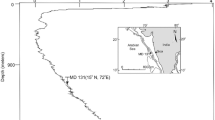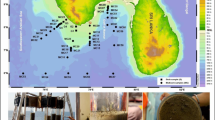Abstract
During the Cenomanian–Turonian transition interval, larger benthic foraminifera became extinct or suffered decreases in terms of their diversity. Anoxic/dysoxic conditions of oceanic bottom water masses and potentially seawater acidification during this pivotal time also affected ecological niches in the shallow epeiric domain and resulted in the demise of many taxa of benthic foraminifera worldwide. Nevertheless, exceptions to this pattern have been reported too. Here, evidence is presented for mass occurrences of larger benthic foraminifera (Perouvianella peruviana) from the Western Platform in Peru that were not affected by environmental conditions related to the Cenomanian–Turonian transition. A new architectural analysis of P. peruviana tests found in abundance in central Peru has permitted a detailed update on its systematic and functional morphology. The paleoenvironment associated with the P. peruviana mass occurrence was characterized by mesotrophic conditions, perhaps in one way or another similar to the environmental parameters that lead to Aptian and Albian larger benthic foraminifera mass occurrences at the southern Tethyan margin (‘Orbitolina levels’). Algae and small, cosmopolitan r-strategist foraminifera coexisted with P. peruviana. Moreover, a first description of the soritid taxa Pseudopeneroplis oyonensis n. gen., n. sp. is provided. Interestingly, the superposition of local and global environmental patterns onto the Western Peruvian shelf water masses triggered a mass development of the Perouvianella population coincident with Oceanic Anoxic Event 2. Conversely, the migration of foreign complex-shelled K-strategist larger benthic foraminifera from neighboring realms was inhibited.









Similar content being viewed by others
References
Arriaga E, Frijia G, Parente M, Caus E (2016) Benthic foraminifera in the aftermath of the Cenomanian–Turonian boundary extinction event in the carbonate platform facies of the southern Apennines (Italy). J Foram Res 46(1):9–24
Arthur MA, Schlanger SO, Jenkyns HC (1987) The Cenomanian–Turonian oceanic anoxic event II: palaeogeographic controls on organic matter production and preservation. In: Brooks J, Fleet A (eds) Marine petroleum source rocks, vol 26. Geological Society Special Publication, London, pp 401–420
Birkeland C (1988) Second-order ecological effects of nutrient input into coral communities. Galaxea:91–100
Bizon G, Bizon JJ, Fourcade E, Vachard D (1975) Nouvelle description d’Archaias (Perouvianella nov. sub-gen) peruviana (Steinmann) 1929, Foraminifère (Peneroplidae) du Sénonien du Pérou. Bull Soc Geol Fr 17(7):1157–1167
Bodin S, Meissner P, Janssen NMM, Steuber T, Mutterlose J (2015) Large igneous provinces and organic carbon burial: controls on global temperature and continental weathering during the Early Cretaceous. Glob Planet Change 133:238–253
Boix C, Villalonga R, Caus E, Hottinger L (2009) Late Cretaceous rotaliids (Foraminiferida) from the Western Tethys. N Jahrb Geol Palӓontol Abh 253:197–227
Boix C, Frijia G, Vicedo V, Bernaus JM, Di Lucia M, Parente M, Caus E (2011) Larger foraminifera distribution and strontium isotope stratigraphy of the La Cova limestones (Coniacian–Santonian, “Serra del Montsec”, Pyrenees, NE Spain). Cret Res 32:806–822
Brčić V, Glumac B, Fuček L, Grizelj A, Horvat M, Posilović H, Mišur I (2017) The Cenomanian–Turonian boundary in the northwestern part of the Adriatic Carbonate Platform (Ćićarija Mtn., Istria, Croatia): characteristics and implications. Facies 63:17
Caus E, Teixell A, Bernaus JM (1997) Depositional model of a Cenomanian–Turonian extensional basin (Sopeira Basin, NE Spain) interplay between tectonics, eustasy and biological productivity. Palaeogeogr Palaeoclimatol Palaeoecol 129:23–36
Consorti L, Caus E, Frijia G, Yagzi-Moghadam M (2015) Praetaberina new genus (Type species: taberina bingistani Henson, 1948): a stratigraphic marker for the late Cenomanian. J Foram Res 45(4):378–389
Consorti L, Boix C, Caus E (2016) Pseudorhapydionina bilottei sp. nov., an endemic foraminifer from the post-Cenomanian/Turonian boundary (Pyrenees, NE Spain). Cret Res 59:147–154
Consorti L, Frijia G, Caus E (2017) Rotaloidean foraminifera from the Upper Cretaceous carbonates of central and southern Italy and their chronostratigraphic age. Cret Res 70:226–243
Cruz-Abad E, Consorti L, Di Lucia M, Parente M, Caus E (2017) Fissumella motolae n. gen. n. sp., a new soritoidean (Foraminifera) from the lowermost Albian carbonate platform facies of central and southern Italy. Cret Res 78:1–7
De Castro P (1971) Osservazioni su Archaias lata (Luperto Sinni). Boll Soc Nat Nap 80:329–363
Di Lucia M, Trecalli A, Parente M, Mutti M (2012) Bio-chemostratigraphy of the Barremian–Aptian shallow-water carbonates of the southern Apennines (Italy): pinpointing the OAE1a in a Tethyan carbonate platform. Solid Earth 3:1–28
Elrick M, Molina-Garza R, Duncan R, Snow L (2009) C-isotope stratigraphy and paleoenvironmental changes across OAE2 (mid-Cretaceous) from shallow water platform carbonates of southern Mexico. Earth Planet Sci Lett 277:295–306
Erba E (2004) Calcareous nannofossils and Mesozoic oceanic anoxic events. Mar Micropal 52:85–106
Fujita K, Hallock P (1999) A comparison of phytal substrate preferences of Archaias angulatus and Sorites orbiculus in mixed macroalgal-seagrass beds in Florida Bay. J Foram Res 29:143–151
Hart MB, Callapez PM, Fisher JK, Hannant K, Monteiro JF, Price GD, Watkinson MP (2005) Micropalaeontology and stratigraphy of the Cenomanian/Turonian boundary in the Lusitanian Basin, Portugal. J Ib Geol 31:311–326
Holzmann M, Hohenegger J, Hallock P, Piller WE, Pawlowski J (2001) Molecular phylogeny of large miliolid foraminifera (Soritacea Ehrenberg, 1839). Mar Micropal 43:57–74
Hottinger L (2001) Archaiasinids and related Porcelaneous Larger Foraminifera from the late Miocene of the Dominican Republic. J Paleont 75(3):475–512
Hottinger L (2006) Illustrated glossary of terms used in foraminiferal research. Notebooks on Geology: Brest, Memoir 2006/2
Hottinger L (2007) Revision of the foraminiferal genus Globoreticulina RAHAGHI, 1978, and of its associated fauna of larger foraminifera from the late Middle Eocene of Iran. Notebooks on Geology: Brest, Memoir 2007/06
Hottinger L (2014) Paleogene Larger Rotaliid Foraminifera from the Western and Central Neotethys. Springer, Berlin, p 191
Hottinger L, Caus E (2009) Meandropsinids, an ophtalmidiid family of Late Cretaceous K-strategist foraminifera endemic in the Pyrenean Gulf. N Jahrb Geol Palӓontol Abh 253:249–279
Huber BT, Leckie RM, Norris RD, Bralower TJ, Cobabe E (1999) Foraminiferal assemblage and stable isotopic change across the Cenomanian–Turonian boundary in the subtropical North Atlantic. J Foram Res 29(4):392–417
Immenhauser A, Della Porta G, Kenter JAM, Bahamonde JR (2003) An alternative model for positive shifts in shallow-marine carbonate δ13C and δ18O. Sedimentology 50:953–959
Immenhauser A, Holmden C, Patterson WP (2008) Interpreting the carbon-isotope record of ancient shallow epeiric seas: lessons from the recent. In: Pratt BR, Holmden C (eds) Dynamics of Epeiric Seas. Geol Ass of Can Spec Publ 48: pp. 135‒174
INGEMMET (1980) Carta Geológica Nacional. San Borja, Lima
Jaillard E (1985) La formation Cajamarca (Turonien supérieur) dans la région de Bambamarca (Andes nord-péruviennes). Approche sédimentologique. Bull Inst Fr d’Etu And 14:49–56
Jaillard E (1986) La sédimentation crétacée dans les Andes du Pérou central: exemple de la Formation Jumasha (Albien moyen-supérieur à Turonien supérieur) dans la région d’Oyón (département de Lima). Géodynamique 1(2):97–108
Jaillard E (1987) Sedimentary evolution of an active margin during middle and upper Cretaceous times: the North Peruvian margin from Late Aptian up to Senonian. Geol Rundsch 76:677–697
Jaillard E, Arnaud-Vanneau A (1993) The Cenomanian–Turonian transition on the Peruvian margin. Cret Res 14:585–605
Jarvis I, Gale AS, Jenkyns HC, Pearce MA (2006) Secular variation in Late Cretaceous carbon isotopes and sea-level change: evidence from a new δ13C carbonate reference curve for the Cenomanian–Campanian, 99.6–70.6 Ma. Geol Mag 143:561–608
Jenkyns HC (1980) Cretaceous anoxic events: from continents to oceans. J Geol Soc 137:171–188
Kuss J (1994) Cretaceous (Albian–Turonian) Calcareous Algae from Egypt and Jordan: systematics, stratigraphy and paleogeography. Abh Geol B A 50:295–317
Langer M (1993) Epiphytic foraminifera. Mar Micropaleontol 20:235–256
Mateu-Vicens G, Khokhlova A, Sebastián-Pastor T (2014) Epiphytic Foraminiferal Indices as bioindicators in Mediterranean Seagrass meadows. J Foram Res 44(3):325–339
Mossadegh ZK, Haig DW, Allan T, Adabi MH, Sadeghi A (2009) Salinity changes during Late Oligocene to Early Miocene Asmari Formation deposition, Zagros Mountains, Iran. Palaeogeogr Palaeoclimatol Palaeoecol 272:17–36
Navarro-Ramirez JP, Bodin S, Immenhauser A (2016) Ongoing Cenomanian e Turonian heterozoan carbonate production in the neritic settings of Peru. Sed Geol 331:78–93
Navarro-Ramirez JP, Bodin S, Consorti L, Immenhauser A (2017) Response of western South American epeiric–neritic ecosystem to middle Cretaceous Oceanic Anoxic Events. Cret Res 75:61–80
Omaña L, Torres JR, Doncel RL, Alencaster G (2016) Cenomanian algae and microencrusters from the El Abra Formation, W Valles-San Luis Potosí, Mexico. Paleo Mex 5(1):53–69
Parente M, Frijia G, Di Lucia M, Jenkyns HC, Woodfine RG, Baroncini F (2008) Stepwise extinction of larger foraminifera at the Cenomanian–Turonian boundary: a shallow-water perspective on nutrient fluctuation during Oceanic Anoxic Event 2 (Bonarelli Event). Geology 36:715–718
Pittet B, van Buchem FSP, Hillgärtner H, Razin P, Grötsch J, Droste HJ (2002) Ecological succession, palaeoenvironmental change, and depositional sequences of Barremian–Aptian shallow-water carbonates in northern Oman. Sedimentology 49:555–581
Raspini A (2012) Shallow water carbonate platforms (Late Aptian–Early Albian, Southern Apennines) in the context of supraregional to global changes: re-appraisal of palaeoecological events as reflectors of carbonate factory response. Solid Earth 3:225–249
Raup DM, Sepkoski JJ (1986) Periodic extinction of families and genera. Science 231:833–836
Reiss Z, Hottinger L (1984) The Gulf of Aqaba. Ecological Micropaleontology, Springer, p 354
Renema W (2008) Internal architecture of Miocene Pseudotaberina and its relation to Caribbean archaiasins. Palaeontology 51(1):71–79
Romani M (1982) Géologie de la région miniére Uchucchatua-Hacienda Otuto. Perou. Thèse 3e cycle, Grenoble, p 176
Schlagintweit F, Wilmsen M (2014) Calcareous Algae (Dasycladales, Udoteaceae) from the Cenomanian Altamira Formation of northern Cantabria, Spain. Act Paleont Rom 10:15–24
Schroeder R, van Buchem FSP, Cherchi A, Baghbani D, Vincent B, Immenhauser A, Granier B (2010) Revised orbitolinid biostratigraphic zonation for the Barremian–Aptian of the eastern Arabian Plate and implications for regional stratigraphic correlations, GeoArabia. Spec Publ 4:49–96
Steinmann G (1929) Geologie von Peru. Karl Winter, Heidelberg, p 448
Takashima R, Nishi H, Yamanaka T, Tomosugi T, Fernando AG, Tanabe K, Moriya K, Kawabe F, Hayashi K (2011) Prevailing oxic environments in the Pacific Ocean during the mid-Cretaceous oceanic anoxic event 2. Nat Commun. https://doi.org/10.1038/ncomms1233
Vilas L, Masse JP, Arias C (1995) Orbitolina episodes in carbonate platform: the early Aptian model from SE Spain. Palaeogeogr Palaeoclimatol Palaeoecol 119:35–45
Acknowledgements
Dr. Felix Schlagintweit (Munich) is thanked for his help in the identification of fossil algae. Comments and discussions with Esmeralda Caus (Barcelona) greatly improved the early version of the manuscript. The financial support of the Spanish Ministry of Economy and Competitiveness (projects CGL2012-33160 and CGL2015-69805-P) is gratefully acknowledged. Comments by reviewers Carles Ferrandez Cañadell (Barcelona) and Annie Vanneau (Grenoble) are highly appreciated. Valuable scientific and editorial comments of Facies editor Maurice Tucker are acknowledged. All of this input has greatly improved the present paper.
Author information
Authors and Affiliations
Corresponding author
Rights and permissions
About this article
Cite this article
Consorti, L., Navarro-Ramirez, J.P., Bodin, S. et al. The architecture and associated fauna of Perouvianella peruviana, an endemic larger benthic foraminifera from the Cenomanian–Turonian transition interval of central Peru. Facies 64, 2 (2018). https://doi.org/10.1007/s10347-017-0514-z
Received:
Accepted:
Published:
DOI: https://doi.org/10.1007/s10347-017-0514-z




